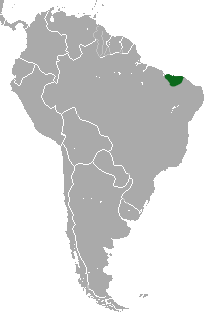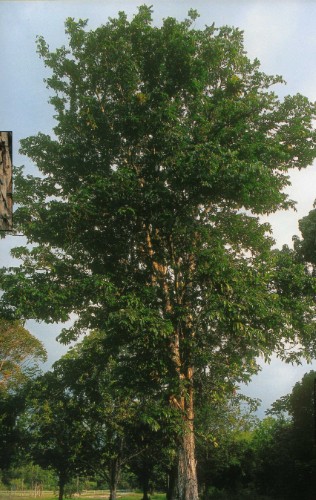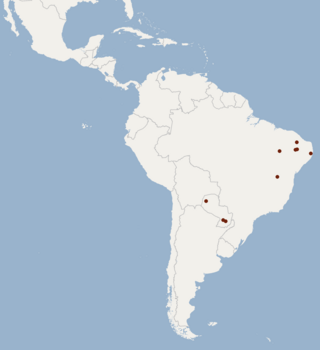
The oncilla, also known as the northern tiger cat, little spotted cat, and tigrillo, is a small spotted cat ranging from Central America to central Brazil. It is listed as Vulnerable on the IUCN Red List, and the population is threatened by deforestation and conversion of habitat to agricultural land.

The golden bat is a bat species found in Brazil, Colombia, French Guiana, Guyana, Suriname and Venezuela.
Neacomys musseri, also known as Musser's neacomys or Musser's bristly mouse, is a rodent species from South America. It is found in far western Brazil and southeastern Peru.
Neacomys paracou, also known as the Paracou neacomys or Paracou bristly mouse, is a rodent species from South America in the genus Neacomys. It is found in northern Brazil, French Guiana, Guyana, Suriname and southeastern Venezuela.

The red-headed Amazon side-necked turtle, red-headed river turtle or red-headed sideneck is a species of turtle in the family Podocnemididae. It is found in the Amazon basin in Brazil, Colombia, and Venezuela. The red-headed river turtle is considered a small turtle with a size of less than 32 cm, making it easily distinguishable from other species in the area. Identifying factors of this turtle include colors ranging from dark brown to black, barbels under the chin, and a bright red strip that goes from behind its head to the tympanum.

Taddei's serotine is a species of medium-sized bat belonging to the family Vespertilionidae. It is restricted to the Atlantic Forest of southern Brazil.

Boto is a Portuguese name given to several types of dolphins and river dolphins native to the Amazon and the Orinoco River tributaries. A few botos exist exclusively in fresh water, and these are often considered primitive dolphins.

Caatinga is a type of semi-arid tropical vegetation, and an ecoregion characterized by this vegetation in interior northeastern Brazil. The name "Caatinga" is a Tupi word meaning "white forest" or "white vegetation" . The Caatinga is a xeric shrubland and thorn forest, which consists primarily of small, thorny trees that shed their leaves seasonally. Cacti, thick-stemmed plants, thorny brush, and arid-adapted grasses make up the ground layer. Most vegetation experiences a brief burst of activity during the three-month long rainy season.

An endangered species is a species that is very likely to become extinct in the near future, either worldwide or in a particular political jurisdiction. Endangered species may be at risk due to factors such as habitat loss, poaching, and invasive species. The International Union for Conservation of Nature (IUCN) Red List lists the global conservation status of many species, and various other agencies assess the status of species within particular areas. Many nations have laws that protect conservation-reliant species which, for example, forbid hunting, restrict land development, or create protected areas. Some endangered species are the target of extensive conservation efforts such as captive breeding and habitat restoration.
Hylaeamys oniscus, the sowbug rice rat, is a rodent species in the family Cricetidae. It was formerly placed in the genus Oryzomys as Oryzomys oniscus.

The Maranhão red-handed howler is an endangered species of howler monkey endemic to forests in the northeastern Brazilian states of Ceará, Maranhão and Piauí. It was previously thought to be a subspecies of the red-handed howler, but unlike that species, the Maranhão red-handed howler is strongly sexually dichromatic.

The cerrado climbing mouse or long-tailed rhipidomys is an arboreal rodent species in the family Cricetidae from South America. It is found in primary or secondary forests of the cerrado and caatinga in central and eastern Brazil, and has also been seen in the Atlantic Forest. Its karyotype is 2n = 44, FN = 48-52. They are nocturnal animals and can be found in both tree canopies and on the ground.
Cerradomys maracajuensis, also known as the Maracaju oryzomys, is a rodent species from South America. It is terrestrial and is found in gallery forests in Bolivia, Paraguay and nearby Brazil and Peru. It was first discovered near the Brazilian city of Maracaju.
The cerrado red-nosed mouse is a rodent species from South America. It is known from one locality in Bahia, eastern Brazil. The species was found in semi-deciduous forest in the cerrado ecoregion.

The Chiriquinan serotine is a species of house bat.

Carapa guianensis is a species of tree in the family Meliaceae, also known by the common names andiroba or crabwood.
Chiroderma vizottoi is a species of frugivorous bat found in the northeast of Brazil.

LaVal's myotis is a species of bat found in Brazil and Paraguay.












